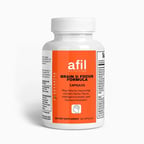Endosulfan (Fungicide)
Endosulfan is a toxic pesticide that can affect the nervous system, liver, and immune health. Limiting exposure, supporting detox, and using specific supplements may help reduce sensitivity.
🚫 What is Endosulfan (Fungicide)?
Endosulfan is a banned pesticide known for its toxicity and long-lasting environmental impact. It can contaminate food and water, affecting the nervous, immune, and hormone systems.
🤔 Why Do I Have a Sensitivity to Endosulfan?
A sensitivity to endosulfan may result from how your body processes and reacts to environmental toxins. Even low-level exposure can trigger symptoms in sensitive individuals due to factors like:
-
Impaired Detoxification: Difficulty breaking down and eliminating toxins can cause buildup and reactions.
-
Genetic Susceptibility: Some people have genes that make them more reactive to chemical exposures.
-
Cumulative Exposure: Previous contact with pesticides or other chemicals may lower your tolerance.
-
Nervous System Reactivity: Endosulfan targets the nervous system, which can lead to heightened sensitivity over time.
-
Immune System Imbalance: Ongoing toxin exposure can disrupt immune regulation, making reactions more likely.
🛠️ What Can I Do About It?
-
🚫 Avoid Exposure: Stick to organic produce, filter your water, and stay clear of recently sprayed areas.
-
🌿 Support Detox Pathways: Eat cruciferous vegetables, stay hydrated, and consider detox-friendly nutrients like glutathione, NAC, or milk thistle.
-
💧 Reduce Inflammation: Focus on anti-inflammatory foods like berries, leafy greens, and omega-3 fats to ease reactivity.
-
🛡️ Strengthen Cellular Defense: Boost antioxidant intake (vitamin C, E, selenium) to help neutralize toxic effects.
-
🧤 Use Protective Barriers: Wear gloves and masks when in areas that may have pesticide residue to limit exposure.
💊 Which Supplements Can Help with an Endosulfan Sensitivity?
-
Glutathione – A powerful antioxidant that supports cellular detox and protects against oxidative stress.
-
N-Acetylcysteine (NAC) – Boosts glutathione levels and helps the liver process toxins more efficiently.
-
Milk Thistle – Supports liver health and regeneration, aiding in the breakdown of harmful compounds.

-
Alpha-Lipoic Acid (ALA) – Helps regenerate other antioxidants and supports detox at the cellular level.

-
Vitamin C – Reduces oxidative stress and supports immune resilience.

-
Selenium + Zinc– Works with glutathione enzymes and supports overall detoxification, immune system defense, and repair of tissues potentially affected by chemical stress.

🌟 Why Might I Have a Sensitivity to Endosulfan if it's a Banned Pesticide?
Even though endosulfan is banned in many places, sensitivity can still happen due to lingering environmental exposure or indirect contact. Here’s why:
- Persistent in the Environment – Endosulfan breaks down slowly and can remain in soil, water, and air for years after use.
- Imported Produce – Some countries still use endosulfan, so it may be present on imported fruits, vegetables, or spices.
- Contaminated Water or Soil – If you live near areas where it was heavily used, residues can still be in groundwater or dust.
- Fat Storage Release – Endosulfan accumulates in fat tissue and may release during weight loss or detox, triggering symptoms.
- Cross-Sensitivities – You might react to similar chemicals or metabolites still used in modern pesticides.
🍽️ Common Sources & Safer Alternatives
💡 Found in (historically, but may still persist in the environment):
-
Agricultural Soil & Dust – Residues from past use may remain in soil and become airborne.
-
Contaminated Water – Runoff from old application sites can pollute rivers, lakes, and groundwater.
-
Imported Produce – Foods from countries where endosulfan is still permitted may carry residues.
-
Animal Fats – It can accumulate in the fat of animals exposed to contaminated feed or grazing areas.
-
Old Storage Areas – Barns or containers that previously held pesticides may retain traces.
-
Global Air Currents – Endosulfan can travel long distances and settle in new environments
🌎 Regions the Endosulfan is Still Used:
-
Certain Developing Countries: Some nations in Africa, Asia, and Latin America still use endosulfan due to its effectiveness and lower cost compared to newer pesticides.
-
Countries with Less Strict Regulations: In areas where pesticide regulations may not be as stringent, endosulfan use can continue despite its known risks.
✅ Alternatives (if tolerated):
- Neem Oil – A natural pesticide that disrupts insect feeding and reproduction, effective against many soft-bodied pests.
- Diatomaceous Earth – A non-toxic powder that physically damages insect exoskeletons, causing them to dehydrate.
- Insecticidal Soap – Made from natural fatty acids, it breaks down quickly and targets soft-bodied insects like aphids and mites.
- Bacillus thuringiensis (Bt) – A soil bacterium used as a biological pesticide that targets specific insect larvae without harming humans or beneficial insects.
- Companion Planting – Strategically planting pest-repelling plants like marigolds, garlic, or basil to protect crops naturally.
- Horticultural Oils – Lightweight oils that smother pests and eggs without leaving harmful residues.
.png?width=100&height=75&name=AFIL%20Logo%20(1).png)